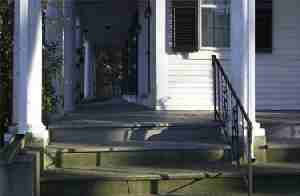Historical
Background and Significance of 9 and 19 Summer Street, proposed site of drive-through
Walgreen's Drugstore
This house and 9 Summer Street were demolished on January 29, 2001.
The site has been incorporated into the Bridgewater Town Historic
District.
Source: Massachusetts Historical Commission
220 Morrissey Blvd.
Boston, MA 02125
Go to 9 Summer Street
19 Summer Street, the Nahum Stetson House
 
| 19 Summer, west side
|
19 Summer, front porch, facing east |

19 Summer, front view
Description
Date: c. 1820
Style: Federal
Architect: Almarine Howard, builder
Outbuildings: barn
Architectural Significance
Essentially T-shaped in plan, this dignified late Federal style house is constructed of
wood. A handsome porch displaying Tuscan columns wraps around the front of this
house. It is 2 stories tall and is crowned by a low hip roof. Its 5-bay main
facade is characterized by tall windows and an elegant fan light-topped main entrance at
the northwestern corner. In general its windows' 6/6 wood sashes are intact.
Abutting the rear wings western wall is a large 19th c. barn.
Historical Significance
This house has significant historical associations with Nahum Stetson, a leading 19th
century Southeastern Massachusetts businessman. He played a leading role in the
early development of Lazell, Perkins Ironworks and was a generous benefactor of the First
Parish Church and Bridgewater Academy. This house was a product of the accelerated
building activity which took place in Bridgewater during the 18s0's--a building boom
precipitated by the incorporation of Bridgewater as a separate town in 1822.
Built c. 1820, this house's builder is said to have been Almarine Howard. It was
initially owned by Nathaniel Washburn, a founder of Carver Washburn Co. Nahum
Stetson paid Washburn $3,200 for "the house and barn" on this property in
October, 1831 [. . . .] Educated at Bridgewater Academy, Stetson became an employee of
Lazell, Perkins &Co. in 1825 at the age of 18. By 1835 he had become the
treasurer of this nationally important ironworks. During the Civil War, under
Stetson's leadership, this company (by that time "The Bridgewater Ironworks")
provided the armor plating for the Union gunboat "The Monitor." In
addition, Mr. Stetson held a staggering number of treasurerships and directorships of
Southeastern Massachusetts companies--including The Weymouth Ironworks, Parker Mills
(Wareham), Dean Cotton Machine Co. (Taunton), Bristol County Bank (Taunton), Taunton
Locomotive Works, Providence Iron Co. and the Old Colony Ironworks (East Taunton).
Understandably enough, he had little time for involvement in state politics. He was
a supporter of the Whig and Republican parties and represented Bridgewater in the State
Legislature from 1838 - 1839. Involved in agricultural pursuits, Stetson operated a large
and productive farm renowned for having "some of the best blooded cattle."
The extensive greenhouses on the grounds of his Summer Street home were a major late 19th
century Bridgewater tourist attraction. Distinguished visitors to the Stetson home
included Daniel Webster and Robert C. Winthrop. By the 1890's their house was owned
by Nahum's grandson, John M. Stetson (1856-1903), second son
of George Barstow Stetson (1830-1883).
Bibliography
Bridgewater Bicentennial Commission. Highlights of History, Bridgewater, MA.
1976.
Hurd. History of Plymouth County. 1894.
Maps and Atlases - 1852, 1879, 1885, 1895, 1901, 1906.
Plymouth County Deeds 176:146.
Thanks to Irma Ruckstuhl for information on the Stetson family.
Return to top
Return to Brunjes Home |